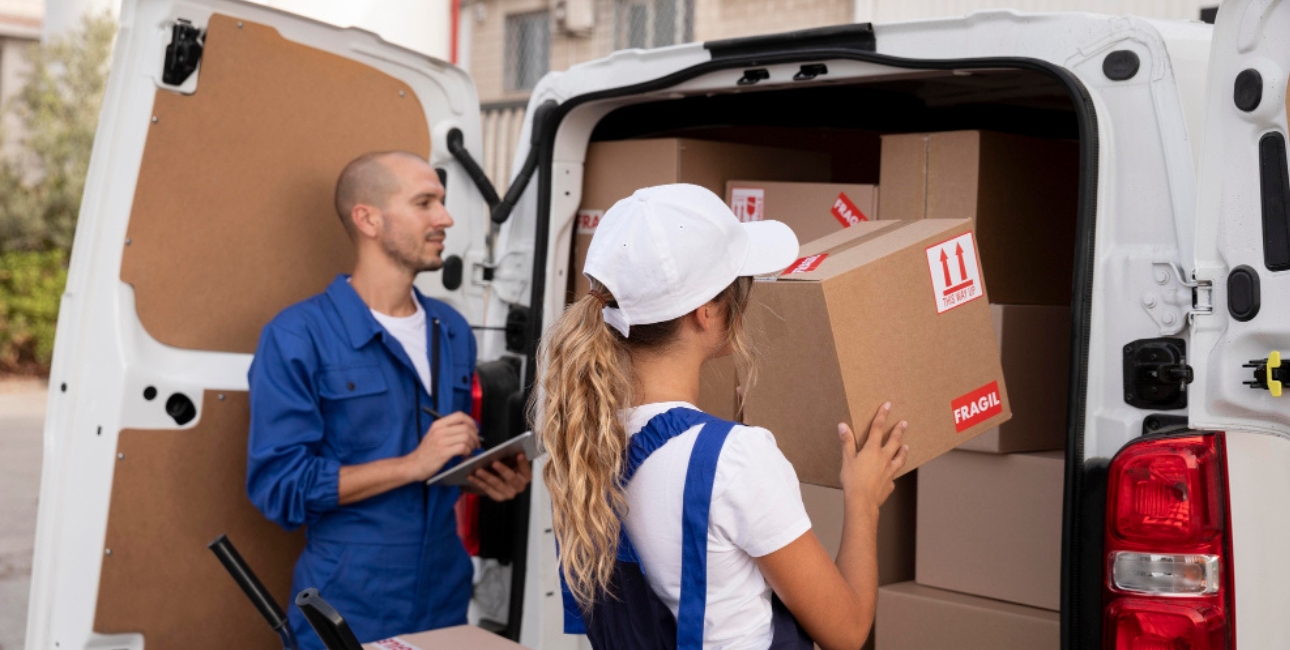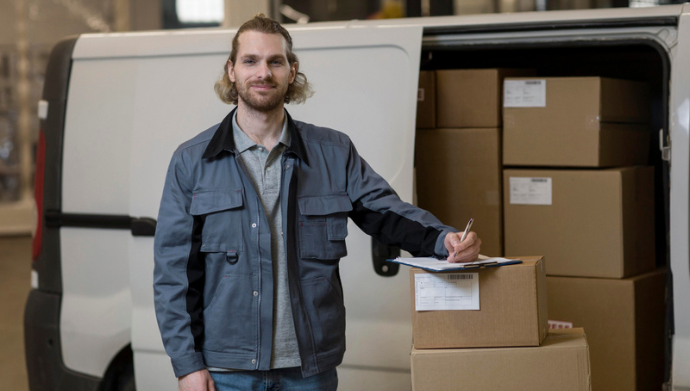Essential Infrastructure for Sustainable Operations of a Moving Company
6 Mins Read
Published on: 06 July 2024
Last Updated on: 14 November 2024

toc impalement
The moving industry thrives on efficiency and reliability. But in today’s environmentally conscious world, sustainable practices are becoming equally important.
Building a foundation for eco-friendly operations requires a focus on infrastructure that minimizes environmental impact while maximizing operational efficiency. In this article, we will explore key elements that contribute to a sustainable moving company.
Tips for Sustainable Operation of Moving Company

Moving company owners can make company operations efficient by applying different tactics. The following options are among the best practices one can follow to reach the utmost level of operational efficiency in the moving company industry.
1. Energy Efficient Moving Fleet
Investing in fuel-efficient vehicles is a crucial first step for a moving & storage company. Consider options like hybrid or electric trucks for local moves, and explore alternative fuel sources like biodiesel for long-distance hauls.
Energy Information Administration notes that until the early 2000s, biodiesel consumption and production in the United States were minimal. Since then, both have increased significantly due to government incentives. These incentives and requirements encourage the production, sale, and use of biodiesel.
Regularly maintain vehicles to optimize fuel efficiency and minimize emissions. Implementing telematics systems can further optimize routes and driving habits, reducing unnecessary fuel consumption.
2. Simplify Customer Booking
Here’s one point that’s often overlooked. Moving companies must simplify their customer booking process. A moving company might provide the best services, but your efforts are wasted if the services aren’t easily available or if the customers have to go through hundreds of steps to get to the service providers.
That’s why it’s best to use a customer relationship management tool. CRM tools make it easy for customers to engage with moving companies and leave with a great experience.
These tools help mover’s business generate leads from different sources like websites, social media, and Google. Once you ensure that all of your customers’ texts, calls, emails, and interactions are logged and accessible easily, you’ve taken care of 50% of the hassle.
Automated email responses, pricing calculations, add-on services, schedule offerings, and inventory assessments make your customer’s journey even better.
SmartMoving, Zoho CRM, and Salesforce CRM are some common names for the best CRM tools. You can choose from these options as per your company’s requirements.
3. Fuel Facility Systems
Shields, Harper & Co. notes that fueling stations represent a significant opportunity to adopt sustainability. Partnering with fuel providers offering low-carbon biofuels is a great first step.
Biofuels are critical for decarbonizing transportation because they provide a low-carbon alternative to current technologies such as light-duty automobiles and heavy-duty trucks.
The International Energy Agency notes that in 2022, biofuel demand hit a record high of 170,000 million liters. This demonstrates the increasing relevance and usage of biofuels in the transportation industry.
An on-site fuel facility system can be designed with features like leak detection systems and water-saving practices. Consider installing solar panels to generate electricity for powering pumps and lighting at the facility, further reducing the company’s environmental footprint.
4. Warehouse Infrastructure
According to Redwood Moving & Storage, warehouses play a crucial role in storing packing supplies and equipment. Utilize space efficiently with vertical storage solutions and implement a system for reusing and recycling packing materials.
Consider using recycled cardboard for boxes and explore biodegradable alternatives for packing peanuts. Invest in LED lighting throughout the warehouse to minimize energy consumption.
LEDs are the gold standard for lighting due to their energy efficiency. Unlike CFLs and incandescent bulbs, which use gas to emit light, LEDs light up through electron movement around a semiconductor. HowStuffWorks notes that LEDs last 25% longer than incandescent bulbs and provide 75 to 80% energy savings.
5. Moving Supplies and Equipment
Moving supplies can often harm the environment. Invest in reusable moving crates and bins whenever possible.
According to Green City Times, the e-commerce boom has resulted in increased demand for cardboard boxes in recent years. As businesses strive to satisfy the packaging requirements for online purchases, their reliance on timber for cardboard manufacture has grown. This increased demand has, unfortunately, intensified timber logging activities, putting significant pressure on forest ecosystems.
For cardboard boxes, prioritize using those made from recycled content and explore options certified by the Sustainable Forestry Initiative (SFI). Opt for biodegradable packing peanuts and choose eco-friendly packing tape made from recycled materials.
6. Technology and Routing for Efficient Operations
Technology plays a vital role in sustainable operations. Implement route optimization software to plan the most efficient routes for moving trucks, minimizing fuel consumption and reducing traffic.
According to Technavio, route optimization software is utilized across various industries, including retail, e-commerce, home services, and 3PL service providers. It enhances freight management by considering both internal and external data. This advanced approach ensures efficient and uninterrupted transportation from origin to destination.
Cloud-based inventory management systems can help reduce paper waste and streamline operations. Employee training programs on eco-friendly practices can further solidify the company’s commitment to sustainability.
7. Recruit & Schedule Properly
Your day-to-day operational efficiency boils down to how you’re scheduling jobs for your moving company crews. Customer moves come in different sizes and shapes. Similarly, the size of your crew is also dynamic.
While operating, most moving companies make the mistake of manually mapping out their gigs and their crews on a spreadsheet or a whiteboard, which is time-intensive. You’ll have your crew calling your office, or you’ll end up reminding them constantly.
You can simplify this entire process with a digital scheduling tool. You can make the process even easier by following these steps –
- First, understand what your customers need. Identify if their requirements are one of the special cases.
- Schedule your best crews for important customers with special needs.
- Balance work across all the movers you appoint.
- Implement a peak pricing model when the workday is too busy and you can hardly take more orders.
- Ask your customers if they would opt for a flexible moving day or not.
- Use scheduling tools to efficiently dispatch your movers.
8. Efficient Route Planning
You can cut down on fuel costs and time and increase operational efficiency with proper route planning. Moving companies should focus on strategic moving route optimization. This not only saves fuel but also has a direct impact on profit from any moving gig.
There is a wide range of data analysis and mapping tools allowing small moving companies to easily optimize their moving routes. With smaller routes and less distance traveled, movers can keep their customers satisfied with their services.
Frequently Asked Questions (FAQs):
For moving companies, limited liability companies (LLCs) are usually the appropriate business structure. It provides liability protection for owners while offering flexible management and tax benefits. An LLC can also make it easier to secure business loans and establish credibility with clients.
Biodiesel is produced by a process known as transesterification, in which vegetable oils or animal fats combine with ethanol. This process produces biodiesel and glycerin as by-products. The biodiesel produced can then be utilized as a renewable fuel in diesel engines.
To make moving more sustainable, use eco-friendly packing materials like recycled boxes. Opt for energy-efficient moving trucks and consolidate shipments to reduce trips. Additionally, to reduce waste and promote a circular economy, look into recycling or donating unwanted products.
Conclusion
Ultimately, creating a sustainable moving company involves more than just utilizing environmentally friendly supplies. It’s a holistic approach that considers every step of the moving process, from fuel efficiency to the reusability of packing supplies.
Moving companies can not only reduce their environmental footprint but also differentiate themselves in an increasingly eco-conscious marketplace by adopting sustainable practices. This commitment to sustainability can resonate with customers and contribute to a greener future for the industry as a whole.
Read Also:


















Comments Are Closed For This Article